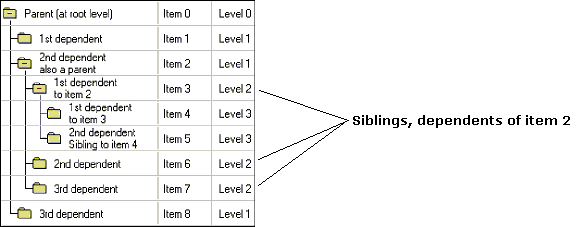Tree Items
An item (also called row) is the term used to refer to one element added to the tree control and includes the row header, all pictures, , expand/collapse buttons and all .
Items are added using the AddString and InsertString functions.
Items within tree controls have relationships to other items based on the level they are on. This determines how items are connected to each other.

The following table defines the terms used throughout to identify relationships and the connecting lines drawn for each type:
| Term | Description |
|---|
| A is an item which has a . The item is said to be a of the . can be themselves or . A cannot be at the . The GetDependent function can be used to retrieve item information for an item. |
| Expand Status | The indicates whether items are visible or not. A that has one or more visible is considered expanded. If a is expanded, all its immediate , i.e., all on the next lower level are visible. If a is collapsed, no immediate are visible. The GetItemExpand function returns the current of an item. |
| Item | A is an item which has no , i.e., it is not a . may have and . |
| Parent | A can be located at any level. In order to become a , an item must be marked expandable (using SetItemExpandable) or have one or more , which are items that immediately follow the and are on a lower level. A may be expanded and collapsed. Expanding a means making its immediate (items on the next lower level) visible. Collapsing a means hiding all its (on all lower levels). The Expand and Collapse functions are used to expand and collapse items. may have and . The GetParent function returns an item's index. |
| Root Level | Any item without is at the , usually level 0. Multiple items can be at the , or . GetItemLevel can be used to retrieve an item's level number. |
| A is an item which precedes or follows another item on the same level with the same . An item can have zero or more . can be and . The GetSibling functions can be used to retrieve information about an item. |
| Top Parent | A is a (or top level ) if it has no of its own. Top may have . The GetTopIndex function can be used to retrieve the topmost . |
| Visibility Status | The indicates whether an item is visible or not. An item is considered visible if its immediate and all other are expanded. An item is considered visible even if it isn't currently displayed in the window client area. The GetItemShown and SetItemShown functions can be used to define an item's . |
When adding items to a tree control, all that is required from an application is that the level numbers are set. The SftTree/DLL tree control automatically determines the correct relationships and draws connecting lines appropriately. Applications can then interrogate the tree control about relationships and don't have to manage these themselves.

